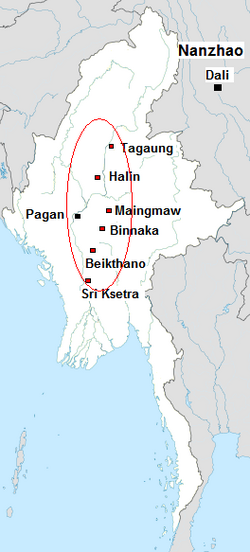Pyu city-states
| Pyu city-states | ||||||||||
| ပျူ မြို့ပြ နိုင်ငံများ | ||||||||||
|
||||||||||
|
The Pyu realm in the red zone
|
||||||||||
| Capital | Sri Ksetra, Halin, Beikthano, Maingmaw, Binnaka | |||||||||
| Languages | Pyu | |||||||||
| Religion | Theravada Buddhism, Mahayana Buddhism, Tantric Buddhism, Hinduism | |||||||||
| Government | Monarchy | |||||||||
| Historical era | Classical antiquity | |||||||||
| • | Earliest Pyu presence in Upper Burma | c. 2nd century BCE | ||||||||
| • | Beikthano founded | c. 180 BCE | ||||||||
| • | Pyu converted to Buddhism | 4th century | ||||||||
| • | Burmese calendar begins | 22 March 638 | ||||||||
| • | 2nd Sri Ksetra Dynasty founded | 25 March 739 | ||||||||
| • | Rise of Pagan Empire | c. 1050 | ||||||||
|
||||||||||
| Pyu Ancient Cities | |
|---|---|
| Name as inscribed on the World Heritage List | |
| Location | Myanmar |
| Type | Cultural |
| Criteria | ii, iii, iv |
| Reference | 1444 |
| UNESCO region | Asia-Pacific |
| Inscription history | |
| Inscription | 2014 (38th Session) |
The Pyu city states (Burmese: ပျူ မြို့ပြ နိုင်ငံများ) were a group of city-states that existed from c. 2nd century BCE to c. mid-11th century in present-day Upper Burma (Myanmar). The city-states were founded as part of the southward migration by the Tibeto-Burman-speaking Pyu people, the earliest inhabitants of Burma of whom records are extant. The thousand-year period, often referred to as the Pyu millennium, linked the Bronze Age to the beginning of the classical states period when the Pagan Kingdom emerged in the late 9th century.
The city-states—five major walled cities and several smaller towns have been excavated—were all located in the three main irrigated regions of Upper Burma: the Mu River Valley, the Kyaukse plains and Minbu region, around the confluence of the Irrawaddy and Chindwin Rivers. Part of an overland trade route between China and India, the Pyu realm gradually expanded south. Halin, founded in the 1st century AD at the northern edge of Upper Burma, was the largest and most important city until around the 7th or 8th century when it was superseded by Sri Ksetra (near modern Pyay) at the southern edge. Twice as large as Halin, Sri Ksetra was the largest and most influential Pyu centre.
The Pyu culture was heavily influenced by trade with India, importing Buddhism as well as other cultural, architectural and political concepts, which would have an enduring influence on the Culture of Burma and political organisation. The Pyu calendar, based on the Buddhist calendar, later became the Burmese calendar. Recent scholarship, though yet not settled, suggests that the Pyu script, based on the Indian Brahmi script, may have been the source of the Burmese script used to write the Burmese language.
...
Wikipedia

